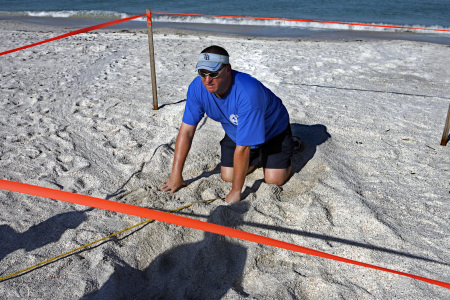http://www.truthout.org/obamas-missing-moral-narrative59968
SUNDAY 30 MAY 2010
Saturday 29 May 2010
by: George Lakoff, t r u t h o u t | Op-Ed

(Photo: jurvetson; Edited: Jared Rodriguez / t r u t h o u t)
Barack Obama may be one of the best communicators of this generation, but he is not living up to his own talents. In a year of disasters, communication failure doubles the disasters.
If, as he says, the monster spill was his highest priority from Day 1, he needed to communicate that from Day 1 – or at least Day 3 or 4. It took five weeks for him to tell the nation what he and his administration were doing. The result was visible in the press conference yesterday. He was on the defensive. He needed to be on the offensive – from early on. The choice is not doing or communicating. It is doing **and** communicating.
His narrative: This is a tough, unprecedented situation, but I’m in charge, and I’ve been very busy, in the Situation Room where I belong, not on TV. I’m fully competent. I’m a good policy wonk – ask me any question about details. I’m honest. I admit my few policy mistakes. I think about the details day and night. Don’t think I’m oblivious.
It’s defensive, trying to overcome criticism that should never have been allowed to accumulate. But worse, it’s weak when it needs to be strong.
The president did do the required minimum. He placed a moratorium on offshore drilling and cancelled oil leases in the Gulf and off Virginia. He appointed a commission to make safety recommendations. And he is reorganizing the Mining Management Service. All to the good, but…
Crises are opportunities. He has consistently missed them. Today was a grand opportunity to pull together the threads – BP and the spill, Massey and the mine disaster, Wall Street and the economic disaster, Anthem BlueCross and health care, the Arizona Immigration Law, Don’t Ask, Don’t Tell, even Afghanistan. The press threw him fastballs straight down the middle, and he hit dribblers every time.
It’s not that he said nothing to tie them together. But there was no home run, no unifying narrative, no patriotic call to the nation on the full gamut of issues. Instead, there were only hints, suggestions, possible implications, notes of concern – as if he had been intimidated by the right-wing message machine.
And yet Obama, of all political leaders, could have done it, because he did before in his campaign.
The central idea is Empathy. Democracy is based on empathy, on people caring about one another and acting to the very best of their ability on that care, for their families, their communities, their nation, and the world. Government must also care and act on that care. Government’s job is to protect and empower its citizens.
That idea is what draws together all the threads. The bottom line for corporations (whether BP, Massey, Anthem or Goldman Sachs) is money, not empathy. The bottom line for those who hate (whether homophobes, the Arizona Legislature, or al Qaeda) is domination and oppression, not empathy.
Empathy, and acting on it effectively, is the main business of government. And Obama knows it in his heart.
Yet the right wing has intimidated Obama into dropping not just the word “empathy,” but the idea. Empathy is a positive deep connection with other people in general and with all living things, the ability to see and feel as they do. The right wing, which shows little empathy, has confused empathy with a bleeding-heart sympathy for individuals, which they see as a weakness. And though Obama has repeatedly made the distinction clear, he has allowed the right wing to intimidate him into abandoning “the most important thing my mother taught me.”
At the very end of the press’ questions, there was a hint of the campaign Obama.
…I think everybody understands that when we are fouling the Earth like this, it has concrete implications not just for this generation, but for future generations.
I grew up in Hawaii where the ocean is sacred. And when you see birds flying around with oil all over their feathers and turtles dying, that doesn’t just speak to the immediate economic consequences of this; this speaks to how are we caring for this incredible bounty that we have.
And so sometimes when I hear folks down in Louisiana expressing frustrations, I may not always think that they’re comments are fair; on the other hand, I probably think to myself, these are folks who grew up fishing in these wetlands and seeing this as an integral part of who they are – and to see that messed up in this fashion would be infuriating.
So the thing that the American people need to understand is that not a day goes by where the federal government is not constantly thinking about how do we make sure that we minimize the damage on this, we close this thing down, we review what happened to make sure that it does not happen again. And in that sense, there are analogies to what’s been happening in terms of in the financial markets and some of these other areas where big crises happen – it forces us to do some soul searching. And I think that’s important for all of us to do.
Here, at the very end, he allows the empathy and the moral vision to come out. Future generations, the sacredness of nature over the immediate economic consequences, caring for this incredible bounty that we have, identifying with folks who see fishing as part of who they are, analogies to what’s been happening in the financial markets, soul searching.
That should have – and could have – been the central narrative drawing all the threads together. The narrative about the daily competence and effort should have been in service of the central narrative of his administration. It should be, and can be, the central narrative of American democracy.
But to make it central and powerful would be confrontational. It would bring him head-to-head with right-wing ideology – empathy-free, self-interest maximizing, with disdain or even hatred for those seen as lesser beings. It is self-reinforcing: a value-system that above all promotes that value-system itself. That is why right-wing Republicans always vote no to his proposals. Because to vote yes would strengthen an empathy-based moral system and weaken their own.
Because right-wing ideology takes precedence over empathy, there will be little or any real bipartisanship with those on the hard-core right. The right is provoking confrontation. It cannot be avoided. The president should be confronting the right wing on all issues – not issue-by-issue as a policy wonk, but with the master moral narrative that makes sense of our country’s values.
Here’s what that would mean. The following “shoulds” are not mine. They follow naturally from President Obama’s own values as he articulated them is his 2008 campaign, and as they leaked out, largely unnoticed, during his press conference.
The president recognizes that financial reform requires dealing with systemic risk, which means not mere regulation, but restructuring the financial system to minimize, and if possible eliminate, systemic risk. Applying the analogy to oil spills, it would mean no more deep-water drilling because major systemic risks (“worst case scenarios”) cannot be eliminated when you drill starting a mile down where no human being can go and drill three miles deeper.
Like other large corporations, BP uses cost-benefit analysis to maximize profits. It is no surprise that, to save money, BP chose inferior materials in Deepwater Horizon, materials whose defects may well have caused the explosion. The use of cost-benefit analysis for a corporation’s benefit (and not the public’s) is a dangerous practice in many industries. Cost-benefit analysis itself, used this way, should be considered as an important component of systemic risk by the President’s commission on safety.
The president should support the Cantwell-Collins CLEAR ACT, which will actually cut gasoline consumption radically by 2050 and carbon emissions by 80% by 2050, while stimulating the economy by providing significant financial dividends to all adult citizens, eliminating government imposition on business, and making those who profit from selling polluting fuel pay to clean it up and develop alternative energy. CLEAR is far superior to cap-and-trade alternatives.
The president should generalize from oil spills to coal mining, banning the blowing up of mountaintops and the fouling of streams, and imposing serious safety restrictions on all mining.
The president should review the covert operations imposed by the military and cancel those that are inconsistent with American values.
The president should order military leaders under his command to support the elimination of Don’t Ask, Don’t Tell.
The president should ask the First Lady to sponsor a major government program to do research on and support empathetic parenting, along the lines of his 2008 Father’s Day speech.
And much more. A great deal follows from a unified moral stance.
Empathy and the discipline to act effectively on it, when seen as the basis of democracy and American values, can be powerful. It can unify the major policies of the administration, and unify people of good will – and that is a majority of our citizens. But only if the president communicates empathy effectively, and acts on it consistently.
Empathy Now!
Special thanks to Richard Charter

